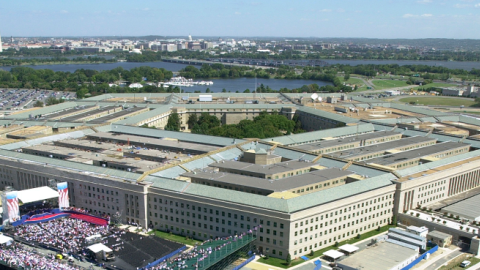In the annals of strategic thought from Sun Tzu through Carl Von Clausewitz, and the chronicles of long public service from Queen Victoria through Adm. Hyman Rickover, Andrew Marshall has an honorable place.
Now 93 years old, Mr. Marshall just this month resigned as director of the Pentagon’s Office of Net Assessment (ONA), which he had headed since its founding in 1973. In the previous four years, he had worked on the National Security Council staff in the Nixon White House. Before that, beginning in 1949, he had devoted 20 years to analyzing U.S. defense matters at the Rand Corp., throughout that think tank’s early Cold War heyday.
THE LAST WARRIOR
By Andrew Krepinevich and Barry Watts
Basic, 305 pages, $29.99
Mr. Marshall is among the handful of thinkers who developed U.S. nuclear-weapons strategy in the 1950s. He pioneered studies of how large organizations make decisions bureaucratically rather than rationally, which was crucial to anticipating the actions not only of our enemies but of our own government. His insights on the strategic role of risk and uncertainty were groundbreaking, helping to counteract the (usually unjustified) certitude that was typical of intelligence-community prognoses. He helped invent the competitive strategies that successive U.S. presidents used to destroy the Soviet Union without war. He is a principal theorist of the “revolution in military affairs” that precision weaponry has enabled. And he fathered the “pivot to Asia” that began in the George W. Bush administration and that President Barack Obama has touted.
But few people know Mr. Marshall’s name. Perhaps because he has kept his public profile low, he has been able to exercise enormous influence for decades.
Two men whom he trained, Andrew Krepinevich and Barry Watts, have written his intellectual history, “The Last Warrior: Andrew Marshall and the Shaping of Modern American Defense Strategy.” The key theme of this thoughtful and fascinating book is the challenge of crafting defense policy without high-quality intelligence—a chronic headache for U.S. officials since America became a leading power after World War II.
Dissatisfaction with the Central Intelligence Agency led to the creation of ONA in 1973. Richard Nixon was president; Henry Kissinger served as both national security adviser and secretary of state. The U.S.-Soviet nuclear-weapons balance was evening up, perhaps on its way to a Soviet advantage. The Soviet defense budget had grown larger than America’s, and U.S. officials worried that America might become weaker than its enemies. The president needed good data and analysis about Soviet military capabilities, vulnerabilities, intentions and strategies.
Mr. Kissinger hired Mr. Marshall away from Rand, telling him that the intelligence the White House was receiving was “lousy” and “even worse than what one could find in the national press.” He asked the 48-year-old analyst to study the problem.
Mr. Marshall was stonewalled when he asked CIA officials why they ignored what they knew to be the president’s particular interests. For example, Nixon was keen to have the personality profiles of foreign leaders, but the CIA wasn’t forthcoming. As Messrs. Krepinevich and Watts explain, the intelligence officials, who had little sympathy for the president’s views, “believed their expertise should dictate what Nixon needed to know; hence, they were providing him with only the intelligence they thought he should be interested in.” Nixon had stopped reading their reports. The CIA, Mr. Marshall learned, used the New York Times as the measure of what was important. Calling this approach “sophomoric,” the book’s authors note that CIA analysts struck Mr. Marshall as being “almost hostile toward the president.” (Even former CIA chief Robert Gates observed in his 1996 memoir that CIA officials at the time were seen as “arrogant.”) It wasn’t helpful that the CIA tended to disagree fundamentally with the White House about what was important in world affairs.
As Mr. Marshall saw it, the policy makers’ thoughts tended to be global, long-term and open to opportunities, not only dangers. Intelligence officials, however, tended to focus on the downside of any proposed action. According to the authors, they injected “personal beliefs into what was supposed to be a rigorous analysis;” their perspective was short-term; and they “didn’t seem to understand what the president and his security adviser were trying to accomplish.” At the heart of the problem, Mr. Marshall said, were oversimplified assumptions about Soviet behavior, including (in Mr. Marshall’s words) a “model of the Soviet government as a single unified actor pursuing an easily stated strategy.”
In July 1973, James Schlesinger, after a six-month stint as CIA director, became secretary of defense. Sharing the president’s frustration over the poor quality of CIA analysis, Schlesinger asked Mr. Marshall to head the newly formed ONA and to analyze the relative power of the United States and the Soviet Union—that is, to assess how the two nations’ strengths and weaknesses netted out.
The authors explain how Schlesinger and Mr. Kissinger disagreed on the Cold War correlation of forces. Mr. Kissinger’s outlook, they write, was shaped by four years at the White House in which he saw “a United States whose power appeared to be waning.” Thus Mr. Kissinger’s policy of relaxing tensions with the Soviet Union, including instituting nuclear-arms-control agreements, was aimed not at defeating the Soviets but at fostering balance and stability.
Believing that attitude to be unduly gloomy, Schlesinger saw the U.S. as stronger and the Soviet Union as weaker than Mr. Kissinger thought. Mr. Marshall agreed. His analysis suggested that military spending was a far larger drag on the Soviet economy than CIA analysts would admit. This meant that time was on America’s side, and “it was the Soviet Union that would eventually find itself on the ropes, not the United States,” as the authors put it. This perspective, we now know, was prescient. Yet until the very end of the Cold War, the authors write, the CIA “consistently asserted that the military burden on the Soviet economy was substantially less than Marshall and Schlesinger believed it to be.”
Critics argued that the type of work done by the Office of Net Assessment was within the intelligence agencies’ domain, but Schlesinger, Mr. Kissinger and Nixon all argued that an independent group was needed to create a solid grounding for U.S. defense strategy.
In a seminal August 1976 report on “The Future of the Strategic Balance,” Mr. Marshall wrote that Soviet leaders aimed not to secure stability based on mutual assured destruction but to ensure the Soviet Union’s survival in the event of nuclear war. He proposed a U.S. strategy of competing with the Soviets in areas of American advantage—for example, quiet submarines and guidance technology—and exacerbating Soviet weaknesses.
President Jimmy Carter’s defense secretary, Harold Brown, saw merit in Mr. Marshall’s approach. He kept ONA in existence, kept Mr. Marshall as director and endorsed Mr. Marshall’s idea that U.S. strategy should include greater efforts to aggravate Soviet weaknesses.
Meanwhile, Mr. Marshall continued to study the Soviet military budget burden and plumbed what was known as the denominator problem: How large is the Soviet economy? The CIA maintained that it was 55%-60% of the size of the U.S. economy. Mr. Marshall saw this CIA estimate as “total hokum” and challenged it, including by drawing on the insights of Soviet émigrés.
Preferring information from clandestine sources, U.S. intelligence officials have for decades tended to disdain information provided by émigrés from enemy states—from Nazi Germany, Saddam Hussein ’s Iraq and elsewhere. Intelligence officials commonly dismiss their stories on the grounds that émigré testimony is unreliable and that émigrés hate their former countries. Mr. Marshall proposed an émigré interview project. Neither the CIA nor the Defense Intelligence Agency, the authors note, was interested: “Their view was that any information gleaned from Soviet émigrés could not be trusted.” So Mr. Marshall funded the project out of his own office’s budget. His émigré sources proved more accurate than the CIA on the size of the Soviet economy: The Soviet Union’s gross national product was around 25%-30% of U.S. GNP. In other words, the CIA was off by over 100%. The authors say that botching the Soviet military burden was “perhaps the most consequential example of official intelligence estimates simply getting it wrong.”
As the Defense Department continually came under new leadership, Mr. Marshall remained influential, even with secretaries with whom he lacked personal rapport, such as Caspar Weinberger during the Reagan years. Mr. Marshall’s approach to making military costs unbearable for the Soviet Union became a pillar of President Reagan’s Cold War strategy. Mr. Marshall championed missile defense as an element of that strategy.
After the Bush administration’s victory in the 1990-91 Gulf War, Mr. Marshall was instrumental in explaining to the Defense Department—and, ultimately, to the world—the long-term significance of so-called smart weapons. During the Bush and Clinton years, Mr. Marshall stressed the need for the military to master all aspects of information warfare. The idea appealed to some strategically minded officials, but, in keeping with Mr. Marshall’s insight about the nature of bureaucracies, various Defense Department offices resisted the idea since it cut against their budgetary interests.
“The Last Warrior” deals only sketchily with the George W. Bush period, so I’ll comment from my own experience about Mr. Marshall’s importance in Donald Rumsfeld ’s Pentagon: Among Mr. Rumsfeld’s first actions was asking Mr. Marshall for a strategic review. The book’s authors say that it ran into resistance from the military service chiefs. It served, they write, as “a cautionary tale about just how difficult it can be to bring about fundamental changes in the thinking and priorities of large organizations.”
Yet Mr. Marshall’s review had a powerful effect on policy. Among other things, it called for greater attention to Asian economic and security developments, specifically to China’s increasing assertiveness and military capability. And it stressed the role of uncertainty in strategic planning.
Mr. Rumsfeld’s defense strategy began with the recognition that the future is unknowable. Unable to predict where our forces will have to operate, we have to assume that we’ll have to move them to use them. Our forces, therefore, should be made light and rapidly transportable. For such forces to be capable of heavy effects, their firepower has to be precise. And to take advantage of precision weapons (smart bombs, anti-missile interceptors and the like), we need exquisite intelligence with the narrowest possible gap between finding a target and firing at it. Thus several of the major themes of Mr. Marshall’s life work became the basis for what Mr. Rumsfeld called his “defense transformation” project and remain the basis of important defense posture changes that have in the past decade or so affected South Korea, Japan, Australia, Guam, Germany, Saudi Arabia and elsewhere.
The book’s title is unfortunate. Andrew Marshall is a civilian, not a warrior. And he’s not the “last” anything, though the authors explain the title by saying he’s the last of the so-called greatest generation. The title can be read to imply that, after Mr. Marshall, there will be no more warriors. Does that mean no more wars? The authors know better than that. They themselves write that one of Mr. Marshall’s important teachings is that war is “an integral part of human nature” and that the “use of military force might be controlled but never banished.” Bad title, but very good book.















